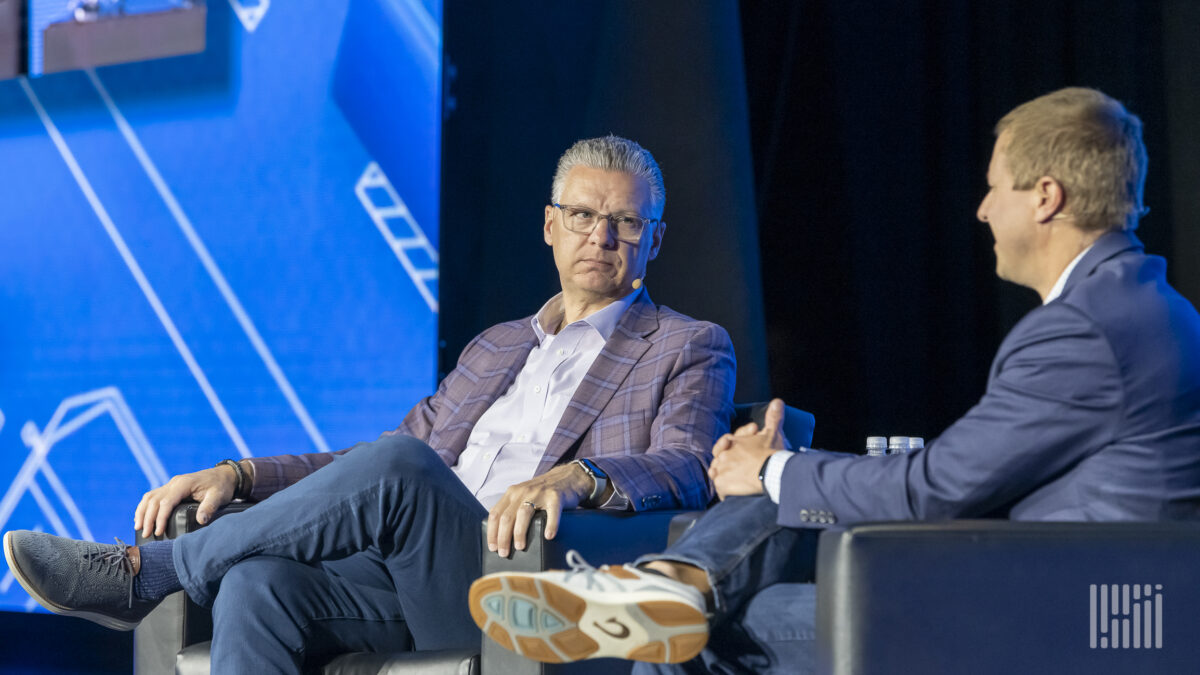CLEVELAND — With the memories of the Long Beach/Los Angeles great port congestion of late 2021 still fresh in the supply chain’s memory, the diversion of freight to other ports remains an ongoing story in maritime trade.
But it isn’t just the big ports of places like Houston or Savannah, Georgia, that have seen a bump. That reality was the core of the final presentation of FreightWaves’ Future of Supply Chain conference, where one of the top officials of the Port of Cleveland, the city that hosted the event, made his case why the city on Lake Erie should be seen as an alternative to the giant gateways.
The congestion issues elsewhere “really shined a light on what benefit inland ports can provide to folks who are using it as somewhat of a relief valve,” Dave Gutheil, the port’s chief commercial officer, said in the closing fireside chat Thursday. “We don’t have the congestion issues that coast ports do when you’re using our container service.”

The reference to containers illustrates that Cleveland is in a small fraternity: ports on the Great Lakes that can take in the big boxes. (Duluth, Minnesota, is the other.)
Container business in Cleveland is small, about 10,000 boxes per year, Gutheil said. Depending on how it’s measured, the volume in Los Angeles/Long Beach would be measured either side of 10 million. Gutheil said Cleveland has the capacity to handle 50,000 containers per year.
But total tonnage at the port has been rising. Port data shows general cargo tonnage last year was 525,486 metric tons, up from 421,755 a year earlier and more than the five-year average of 402,886 tons.
But with the LA/Long Beach congestion and other port issues looming over activity at the West Coast port, other ports are looking to take advantage. Cleveland is not unique.
Growing container tonnage in Cleveland has its challenges, Gutheil said, citing two particularly large problems.
One is the fact that the St. Lawrence Seaway, which connects the Great Lakes system to the Atlantic Ocean, shuts down for winter “seasonality.” But Gutheil said that is not because of freezing conditions. Rather, it is because of the maintenance on the locks systems that goes on at that time.
The current mix of freight in Cleveland includes imported steel from northern and central Europe, which was highlighted by a warehouse full of tinplate visible on a bus tour Thursday. Bulk commodities like cement and salt are a staple of the port, as well as “a huge amount of iron ore.” Most of the iron ore is from the northern Great Lakes and moves on Jones Act vessels, Gutheil said.
(Iron ore as a product shipped into the port is part of the legendary lyrics of “The Wreck of the Edmund Fitzgerald,” which sank in Lake Superior in 1975 after “concluding some terms with a couple of steel firms, when they left fully loaded for Cleveland.”)
Asked in the fireside chat by FreightWaves’ Zach Strickland about the biggest change Gutheil would want to see, the port executive said, “That is an easy one for me: Get rid of the seasonality.
“There are lots of other parts of the world that are open year-round,” Gutheil said. “In order for the St. Lawrence Seaway system to grow and handle the cargo that it did back in the early ’70s, we need to solve the seasonality issue plain and simple.”
Without that, Gutheil said, the St. Lawrence Seaway “will still be kind of a niche system.” With that winter closure in place, or greatly reduced, it would not be necessary for cargo owners “to not have to change their routings for two and a half months.”
Gutheil said separately that ice-breaking capabilities could deal with the seasonal issue of cold weather to keep the seaway operating in winter.
Fixing the seasonality hurdle would need to be accomplished through what Gutheil said would be a “binational agreement” between the U.S. and Canada.
A second problem that limits container traffic into the Great Lakes is that the St. Lawrence Seaway can’t handle Panamax-size vessels, Gutheil said. A large container ship would need a system of smaller vessels transiting into the Great Lakes in some sort of transshipment program.
In his remarks and later during the bus tour of the port for conference attendees, Gutheil spoke about the port’s excitement about taking in its first bulk liquid shipment in the next month. The shipment of palm oil is coming from Indonesia.
The unidentified customer is located about 30 miles east of Cleveland, Gutheil said. The palm oil will be shipped from the port via rail.
A bigger takeaway from that shipment, Gutheil said, is that it’s coming from Asia. “That’s the next big market that we’re not participating in very much right now that we really need to look into for further growth.”
Sitting on the Great Lakes, an obvious question for any port looking to expand is how it can serve the automobile industry. Gutheil said he has seen “more interest from the automobile companies trying to use our system than ever before during the last couple of years.”
But so far, it has been mostly talk. “We have met with them a number of times, as have other ports around the system, trying to figure out how to get around the [seasonality] closure,” Gutheil said. “So I think they would be 100% behind these issues as well.”
More articles by John Kingston
Labor Department’s independent contractor rule not likely anytime soon
California’s AB5 argument: Trucking in state hasn’t become chaotic
HumanProgress.org founder: Time is money, and we’re all getting richer










